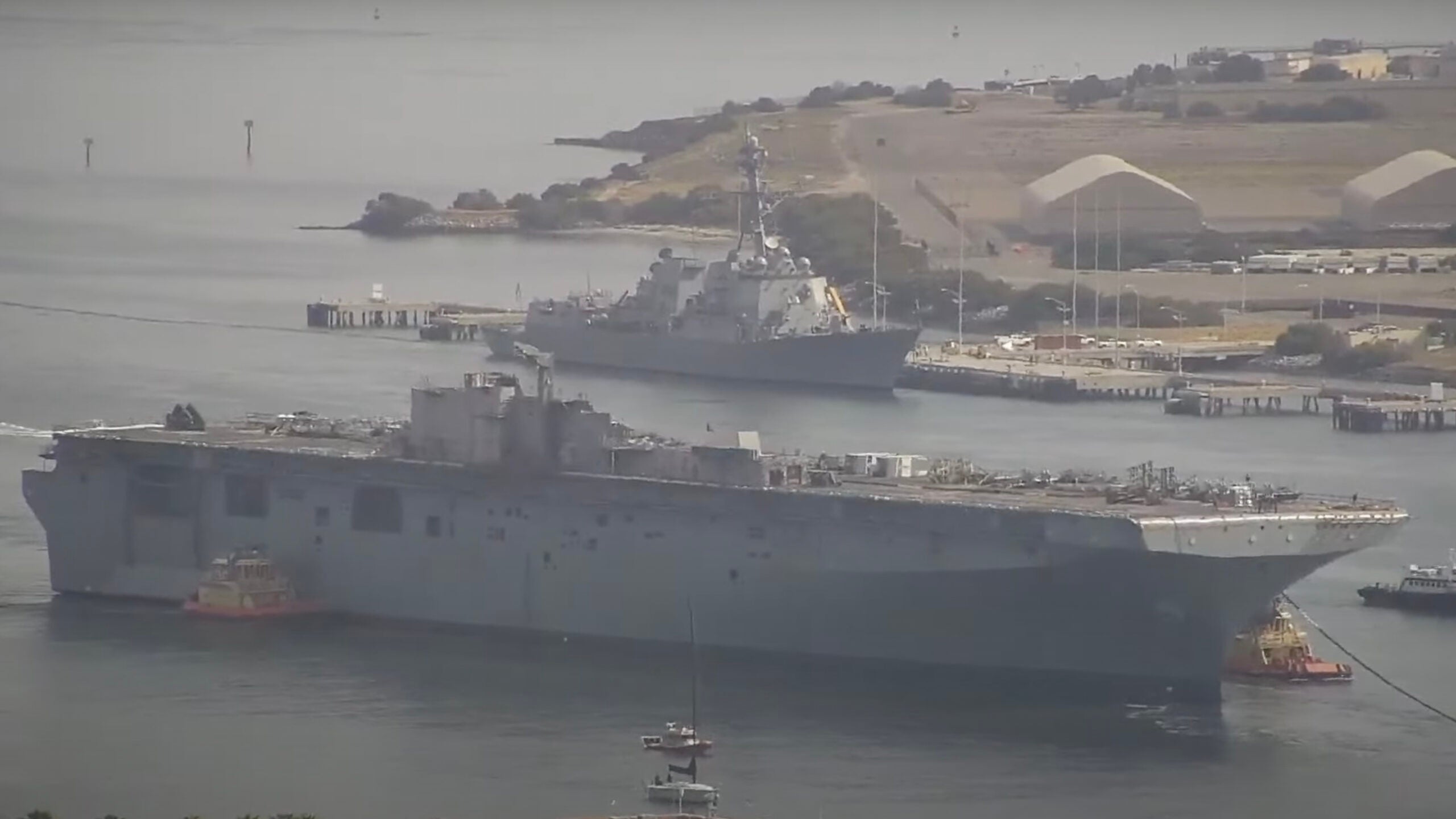What’s left of the U.S. Navy’s former amphibious assault ship USS Bonhomme Richard was seen being taken under tow yesterday, headed from Naval Base San Diego, California, to its eventual destination — the International Shipbreaking Limited facility in Brownsville, on the Texas coast. The ship, also known by its hull number LHD-6, suffered a fire that raged for days last year, causing a massive amount of damage, leading to the decision to decommission and scrap it, a process that is estimated will cost around $30 million.
According to a report from USNI News, the hull of the former Bonhomme Richard will be towed around the tip of South America and then onward to Texas, for dismantling.

Work to remove the island began in February this year, according to USNI News, reducing the overall height of the ship for transit, and other useful spares were also stripped from the vessel while it was still in San Diego. The entire process of reducing the Bonhomme Richard to scrap is expected to take between nine months and a year.

The fire aboard the ship burned for around four days beginning on July 12 last year. It started in a lower vehicle storage area and set off multiple blazes that damaged some 60 percent of the ship, which was sitting pier-side in San Diego undergoing maintenance at the time. The island, mast, and flight deck suffered particularly heavy damage. A total of 63 sailors and civilian firefighters were injured in the incident, which was covered in depth by The War Zone at the time.

Multiple investigations are still underway to determine the cause of the fire, but last August the service revealed that it was looking into the possibility of arson being a factor.
The Navy decided that it would be too expensive to repair the warship or to convert it for another use such as a hospital ship or submarine tender and, last November, decided to scrap it. It was disclosed that rebuilding it as an LHD would have cost upward of $3 billion and taken between five and seven years; the cost of a brand-new America-class assault ship, by contrast, is around $4 billion.

The fire onboard Bonhomme Richard came amid an apparent spate of similar incidents that befell U.S. warships. Another smaller, fire broke out on board Bonhomme Richard’s sister ship, USS Kearsarge last summer, and the future USS John F. Kennedy, a Ford-class aircraft carrier suffered a blaze while still under construction. Shipboard fires have also affected the U.S. Coast Guard in recent months, too.

For the wider Navy, the loss of Bonhomme Richard reduced the Wasp class to seven vessels, which will have to bear the brunt of most amphibious assault operations. These are joined by two of the newer America-class amphibious assault ships, with a third, the future USS Bougainville, under construction. It comes, too, at an inopportune time, with the service pushing a proposed plan to increase its fleet size to more than 500 ships by 2045.
The Navy bid an official farewell to the warship with a ceremony in San Diego on April 14, while an official release highlighted some of the milestones in the history of the Wasp-class vessel, which was commissioned in 1998. Early in its career, the Bonhomme Richard took part in Operation Stabilize in February 2000, providing peacekeeping and humanitarian operations off the coast of East Timor in Southeast Asia.

During Operation Iraqi Freedom in 2003, Bonhomme Richard offloaded more than a thousand Marines and their equipment from the 3rd Battalion, 1st Marines into Kuwait. After delivering attack and transport helicopters, plus troops and vehicles, AV-8B Harrier II jump jets flew missions from its deck into Iraq. In the process, the Harriers expended more than 175,000 pounds of ordnance while providing close air support to Marines on the ground.
Between 2012 and 2018, Bonhomme Richard was based at Sasebo in Japan, assigned as the command ship for the forward-deployed amphibious forces in the Pacific.
Most of the sailors from the Bonhomme Richard have been reassigned to different vessels in the fleet, leaving a skeleton crew aboard for the decommissioning, the ceremony for which you can watch in full below:

Speaking at the decommissioning ceremony earlier this week, Rear Admiral Philip Sobeck, the commander of Expeditionary Strike Group 3, provided the following words on the “Bonnie Dick”:
“Sailors gave their all to prevail against seemingly impossible odds, and they won. They taught us that you don’t always save the ship, but you never stop fighting. The reputation of that fighting spirit began to proceed our Navy wherever we sailed and that same spirit persists today.”
Whichever way you look at it, it’s a sad end for the amphibious assault ship, which provided years of good service during a career that was cut roughly in half.
Contact the author: thomas@thedrive.com
